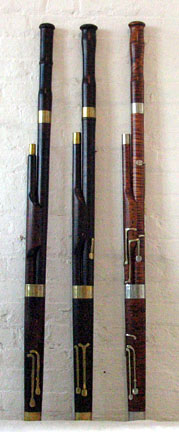
- Bühner
& Keller Classical, 430 curly maple
- Heinrich
Grenser Classical, 430 curly maple
- Wiesner
Romantic, +/- 438 curly maple
|
- Bühner
& Keller Classical, 430 curly maple
- Heinrich
Grenser Classical, 430 curly maple
- Wiesner
Romantic, +/- 438 curly maple
|


This instrument is modeled after two specimens.
Bühner and Keller were Strasbourg makers, and it was
their instrument that was played and endorsed by Étiène
Ozi in his famous bassoon method of 1803. With an open and direct feel
and great flexibility it is a good example of a
French style instrument of the period.
This instrument, pitched at
A-430Hz with brass ferrules, has seven brass keys and plays easily up
to high C. It is made out of curly maple with a nitric acid stain and
is available with a choice of two bocals.

We are fortunate that numerous instruments of this
famous Dresden maker have survived to be played, measured and compared.
This copy is based on an early Saxon Swords H.Grenser stamped
instrument that along with wooden keys has small ornamental turning
touches. This classical instrument with eight brass keys (additional
key of Bb may be added), pitched at A-430Hz. It has a rich dark tone
and
a solid and even chromatic scale. It is built out of curly maple with a
nitric
acid stain and is available with a choice of two bocals.
TOP
|
|


Sammuel
Gottfried Wiesner, apprentice and successor of H.Grenser, brought this
Saxon instrument to its final stages before being superceded by the
modern German bassoon.
This instrument is based
on a sixteen-keyed bassoon of remarkable playing characteristics and
workmanship in the collection of Henk de Wit. Its nickel-silver keys
include a high d key, an alternate Ab/G# key, a padded low C and closed
low Bb key. Although the wider 'Almerader'-type bore was already long
in existence at this time, an advertisement of 1849 describes this
instrument and its merits in detail. It is built out of curly maple and
can be tuned to favour a number of different pitches.
TOP
|


